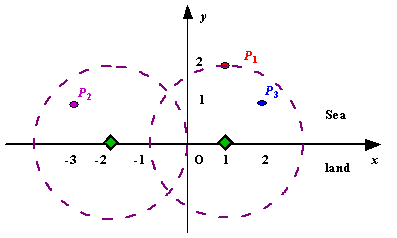Radar Installation
| Time Limit: 1000MS | Memory Limit: 10000K | |
| Total Submissions: 77040 | Accepted: 17257 |
Description
Assume the coasting is an infinite straight line. Land is in one side of coasting, sea in the other. Each small island is a point locating in the sea side. And any radar installation, locating on the coasting, can only cover d distance, so an island in the sea can be covered by a radius installation, if the distance between them is at most d.
We use Cartesian coordinate system, defining the coasting is the x-axis. The sea side is above x-axis, and the land side below. Given the position of each island in the sea, and given the distance of the coverage of the radar installation, your task is to write a program to find the minimal number of radar installations to cover all the islands. Note that the position of an island is represented by its x-y coordinates.

Figure A Sample Input of Radar Installations
We use Cartesian coordinate system, defining the coasting is the x-axis. The sea side is above x-axis, and the land side below. Given the position of each island in the sea, and given the distance of the coverage of the radar installation, your task is to write a program to find the minimal number of radar installations to cover all the islands. Note that the position of an island is represented by its x-y coordinates.

Figure A Sample Input of Radar Installations
Input
The
input consists of several test cases. The first line of each case
contains two integers n (1<=n<=1000) and d, where n is the number
of islands in the sea and d is the distance of coverage of the radar
installation. This is followed by n lines each containing two integers
representing the coordinate of the position of each island. Then a blank
line follows to separate the cases.
The input is terminated by a line containing pair of zeros
The input is terminated by a line containing pair of zeros
Output
For
each test case output one line consisting of the test case number
followed by the minimal number of radar installations needed. "-1"
installation means no solution for that case.
Sample Input
3 2 1 2 -3 1 2 1 1 2 0 2 0 0
Sample Output
Case 1: 2 Case 2: 1
Source
1 #include <cstdio> 2 #include <cstring> 3 #include <queue> 4 #include <cmath> 5 using namespace std; 6 7 const int maxn=1005; 8 typedef struct islands{ 9 double l,r; 10 islands(double l=0,double r=0):r(r),l(l){} 11 }I; 12 struct cmp{ 13 bool operator()(const I &a,const I &b){ 14 return a.r>b.r; 15 } 16 }; 17 priority_queue<I,vector<I>,cmp>que; 18 int main() 19 { 20 int n,ans,ca=1; 21 double d,x,y,z,lef; 22 bool flag; 23 while(scanf(" %d%lf",&n,&d)==2&&n&&d) 24 { 25 flag=false; 26 ans=0; lef=-100000000; 27 for(int i=0;i<n;i++){ 28 scanf("%lf%lf",&x,&y); 29 if(y>d) flag=true; 30 z=sqrt(d*d-y*y); 31 que.push(I(x-z,x+z)); 32 } 33 if(flag){printf("Case %d: %d ",ca++,-1); continue;} 34 I ra=que.top(); que.pop(); ans++; 35 lef=ra.r; 36 while(que.size()){ 37 ra=que.top(); 38 que.pop(); 39 if(lef>ra.r) lef=ra.r; 40 else if(lef<ra.l){ans++; lef=ra.r;} 41 } 42 printf("Case %d: %d ",ca++,ans); 43 } 44 45 }